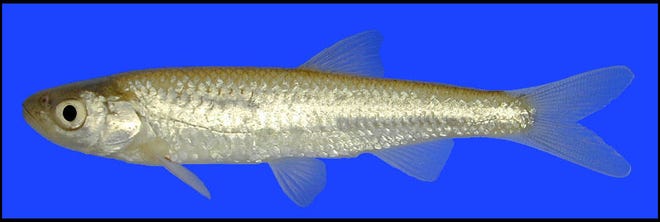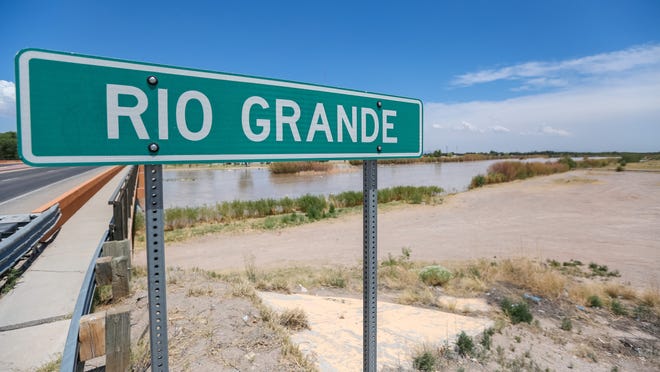
A three-inch fish dwelling in the Pecos River in southeast New Mexico could see federal protections as the U.S. Fish and Wildlife Service agreed to investigate whether it should be listed as endangered.
The Rio Grande shiner was once known to live in drainage waters of the Rio Grande in New Mexico, Texas and Mexico, including headwaters in northern New Mexico down to the Rio Grande delta on the Texas coast.
In Mexico, it was believed to exist In the Rio San Juan, Rio Salado and Rio Conchos – all tributaries of the Rio Grande, known as the Rio Bravo del Norte in Mexico and flowing across the U.S.’ southern border.
More:Conservationists renew push to save New Mexico lesser prairie chicken. Feds to decide by May
Estimates show that the shiner could have once inhabited up to 2,600 river miles, but conservationists believe today it can only be found in about 500 miles in southeast New Mexico, meaning the fish has only 20 percent of its historic range.
In January, Santa Fe-based WildEarth Guardians petitioned the U.S. Fish and Wildlife Service to list the Rio Grand Shiner as threatened or endangered which would trigger federal restrictions on land use in and around the shiner’s known habitat while a recovery plan was devised.
The Service issued a 90-day finding on Tuesday which found a listing could be warranted and required 12-month finding to be developed for a deeper study and potential final decision.
Tricia Snyder, Rio Grande campaigner at WildEarth Guardians said the depletion of the Rio Grande shiner’s habitat was indicative of failed management of the river itself.
She said a listing would be a step toward restoring the Rio Grande, and the diversity of habitats and species that depend on it.
More:A butterfly’s last stand: Federal listing sought for rare species in Sacramento Mountains
“Generations of plant and wildlife communities have relied on this living river, now at the heart of the extinction crisis in the Southwestern US,” Snyder said. “Without a serious course correction in water management we risk permanent ecological damage and forever losing species like the Rio Grande shiner.”

A tiny fish with big implications for New Mexico’s imperiled river
The Rio Grande shiner grows to about 2.95 inches or 75 millimeters, per a report from Texas State University.
It is characterized as mostly silvery in color with lateral scales and a slender body.
The shiner prefers turbid or cloudy water with low flow speeds and downstream pools.
During mating season, they move to wide river channels with loose shifting sand.
Males nudge their female in the abdomen, eventually wrapping themselves around their prospective mate as eggs are expelled simultaneously with seminal fluid.
Several spawning episodes can occur, but the shiners typically take about a 10-minute break in between.
After the spawning process, the eggs develop as they flow down the river, requiring adequate currents to keep them safe from smothering sediment.
More:One last flight: Injured pelican delivered by plane to new home at Carlsbad wildlife center
Much of the habitat needed for the Rio Grande Shiner to reproduce and flourish has disappeared in recent years, and it now only calls home small stretches of the Pecos River in Eddy, Chaves and De Baca counties in the drought-prone southern region of New Mexico.
In Texas, its historical range was almost entirely depleted with the U.S. Fish and Wildlife Service reporting a few individual fishes found in the Rio Grande in Maverick County along the Mexico border southeast of San Antonio.
The Fish and Wildlife Service listed reduced stream flow, damming and human- or natural-cased water quality degradation as primary threats to the shiner.
More:Fighting for a fish: Saving the peppered chub could restore a river in northeast New Mexico
Climate change, poor river management blamed for habitat destruction
The shiner was already listed as a “threatened” species by the Texas Parks and Wildlife Department in early 2020 but was not listed by the New Mexico Department of Game and Fish as of its latest listing report for 2020.
“Large portions of the historical range of the Rio Grande shiner have been altered or destroyed,” read the Fish and Wildlife Service’s 90-day finding. “Reduced flow, increased salinity, and golden algae blooms have caused population losses from which the Rio Grande shiner have never fully recovered.
“The petition presents substantial information indicating that the petitioned action may be warranted due to the effects of habitat modification and destruction throughout the historical range of Rio Grande shiner.”
More:The mighty mollusk: Feds propose plan to restore Texas hornshell mussel in New Mexico
The Service also found that existing regulations and management practices on the Rio Grande were inadequate to protect the shiner and the resulting water depletion was so severe that water was transferred in from the San Juan River in four corners region of the northwest New Mexico.
“Laws and regulations surrounding water use in the Rio Grande basin are largely based on beneficial uses for human populations, and not focused on maintaining instream flows,” the finding read.
“The petition contains substantial information that the petitioned action may be warranted due to inadequate water laws and regulations that fail to prevent low flows and river drying.”
More:Federal government looks to open up dunes sagebrush lizard habitat to oil and gas
Other threats were human population growth along the river leading to increased water demands, along with climate change and reducing snowpacks in the mountains of northern New Mexico which melt and feed into the river.
“Decreases in snowpack and increases in temperature are likely to have detrimental effects on stream flow in rivers in the southwestern United States,” the finding read.
“The Rio Grande shiner is a short-lived species and prolonged disturbances due to climate change may cause diminished spawning success, leading to declines or extirpation of isolated populations.”
More:A future for the flower: Wright’s marsh thistle to be federally protected in New Mexico
Lindsay Larris, wildlife program director with WildEarth Guardians said the federal government must take action to save the shiner and prevent further devastation to the once-mighty Rio Grande.
“In recent years, it has taken more than a decade for imperiled species to go through the entire ESA listing process and the Rio Grande shiner needs action much more swiftly to prevent its extinction,” she said.
“We are optimistic that a new administration understands the urgency of the biodiversity crisis and will devote more resources to ensure listing decisions are made while preventing extinction is still an option.”
Adrian Hedden can be reached at 575-618-7631, achedden@currentargus.com or @AdrianHedden on Twitter.







